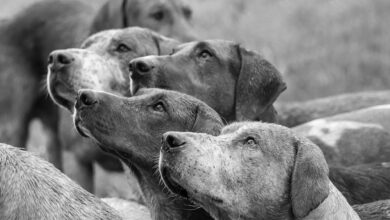all dog breeds

all dog breeds
Dogs have been our loyal companions for thousands of years, and their diverse breeds are a testament to the unique bond between humans and canines. Understanding dog breeds is essential for potential dog owners, as it allows them to choose a breed that aligns with their lifestyle, personality, and preferences. Each breed has its own set of characteristics, temperaments, and needs, making it crucial to do thorough research before bringing home a new furry friend.
The Origins of Dog Breeds: How Different Breeds Came to Be
The evolution of dogs from wolves is a fascinating journey that spans thousands of years. It is believed that dogs were domesticated from wolves around 15,000 years ago, as humans began to form settlements and develop agriculture. Over time, selective breeding played a significant role in shaping different breeds. Humans selectively bred dogs with desirable traits such as hunting skills, herding abilities, or companionship qualities, resulting in the wide variety of breeds we see today.
Certain breeds also hold historical significance. For example, the Border Collie was developed in the border region between England and Scotland for herding sheep. These dogs were highly valued for their intelligence and agility, making them indispensable to farmers in the region. Similarly, the German Shepherd breed was originally bred for herding sheep but later gained recognition for its exceptional skills in police and military work.
Popular Dog Breeds: A Look at the Most Commonly Owned Breeds
In the United States, certain dog breeds have consistently ranked among the most popular choices for pet owners. The American Kennel Club (AKC) provides an annual list of the top 10 most popular dog breeds based on registration statistics. These popular breeds include Labrador Retrievers, French Bulldogs, German Shepherds, Golden Retrievers, Bulldogs, Poodles, Beagles, Rottweilers, German Shorthaired Pointers, and Dachshunds.
Each of these breeds has its own unique characteristics and traits. Labrador Retrievers, for example, are known for their friendly and outgoing nature, making them excellent family pets. On the other hand, German Shepherds are highly intelligent and protective, making them ideal for roles in law enforcement or as service dogs. While owning a popular breed can have its advantages, such as a wealth of information and resources available, it’s important to consider the potential drawbacks as well, such as higher demand and potential health issues associated with overbreeding.
Rare Dog Breeds: Exploring the Lesser-Known Breeds of the Canine World
| Akbash | Turkey | 10-12 years | 28-34 | 90-140 |
| Catahoula Leopard Dog | United States | 10-14 years | 20-26 | 50-95 |
| Chinook | United States | 12-15 years | 22-26 | 50-90 |
| Komondor | Hungary | 10-12 years | 25-30 | 80-100 |
| Peruvian Inca Orchid | Peru | 11-12 years | 18-26 | 20-55 |
While popular breeds often dominate the spotlight, there are numerous rare dog breeds that deserve recognition. Rare breeds are those with a small population or limited availability. These breeds often have unique characteristics that set them apart from more common breeds. Examples of rare breeds include the Azawakh, a slender and elegant sighthound from West Africa, or the Xoloitzcuintli, a hairless breed with ancient Mexican origins.
Owning a rare breed can be an exciting experience for dog enthusiasts who appreciate the novelty and distinctiveness of these dogs. However, it’s important to consider the potential challenges that come with owning a rare breed. Limited availability may make finding a reputable breeder more difficult, and there may be fewer resources and support networks available for rare breed owners.
Working Dog Breeds: Dogs with Jobs and Their Unique Characteristics

Working dog breeds are known for their intelligence, trainability, and strong work ethic. These breeds have been selectively bred for specific tasks and jobs throughout history. Examples of working breeds include Border Collies, Siberian Huskies, Boxers, Doberman Pinschers, and Great Danes.
Border Collies are renowned for their herding abilities and are often used on farms to manage livestock. Siberian Huskies, with their endurance and strength, excel in sled pulling and are commonly used in dog sledding competitions. Boxers, known for their loyalty and protective nature, make excellent guard dogs. Doberman Pinschers are highly intelligent and have been utilized in various roles, including police work and search and rescue missions. Great Danes, despite their gentle nature, were historically bred for hunting large game.
Toy Dog Breeds: Small in Size, Big in Personality
Toy dog breeds are characterized by their small size and often possess larger-than-life personalities. These pint-sized pups are adored for their companionship and make great pets for those living in apartments or with limited space. Examples of toy breeds include Chihuahuas, Pomeranians, Yorkshire Terriers, Shih Tzus, and Cavalier King Charles Spaniels.
Chihuahuas are known for their feisty and confident nature, while Pomeranians are lively and playful. Yorkshire Terriers are bold and independent, while Shih Tzus are affectionate and friendly. Cavalier King Charles Spaniels are gentle and loving companions. However, it’s important to consider the potential challenges of owning a toy breed, such as fragility and potential health issues associated with their small size.
Choosing the Right Dog Breed: Factors to Consider Before Bringing Home a New Furry Friend
When choosing a dog breed, there are several factors to consider to ensure a successful match between the owner’s lifestyle and the dog’s needs. Lifestyle considerations include the amount of time available for exercise and socialization, as well as the owner’s activity level. Some breeds require more exercise and mental stimulation than others.
Living arrangements also play a role in breed selection. For example, living in an apartment may require a smaller breed that is more adaptable to limited space. Grooming and maintenance requirements should also be taken into account, as some breeds require regular grooming and others shed more heavily.
Health concerns are another important consideration. Some breeds are prone to certain genetic health conditions, and potential owners should be aware of these risks and prepared for any necessary medical care.
Understanding dog breeds is crucial for potential dog owners to ensure a harmonious and fulfilling relationship with their furry companions. By researching different breeds, their characteristics, and their specific needs, individuals can make an informed decision that aligns with their lifestyle and preferences. Whether choosing a popular breed, exploring rare breeds, opting for a working dog, or considering a toy breed, each choice comes with its own set of advantages and challenges. By carefully considering factors such as lifestyle, living arrangements, activity level, grooming requirements, and health concerns, individuals can find the perfect breed that will bring joy and companionship into their lives for years to come.



